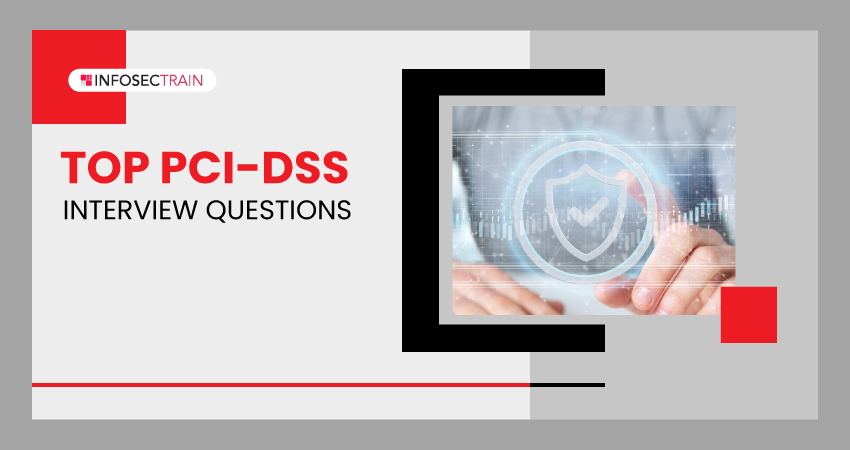Top PCI-DSS Interview Questions
The Payment Card Industry Data Security Standard (PCI DSS) is a critical standard for any organization that processes, stores, or transmits payment card data. Whether you are a seasoned professional or new to PCI DSS, it is essential to grasp its intricacies, especially if you’re wondering how to prepare for a PCI DSS interview.

In this article, we have provided some PCI DSS compliance interview questions, ensuring you are well-equipped to navigate this vital facet of cybersecurity.
1. What is PCI DSS, and why is it important?
Answer: PCI DSS stands for Payment Card Industry Data Security Standard. It is a set of security standards designed to ensure the secure handling, processing, and storage of payment card data (such as debit or credit card numbers) to safeguard against data breaches and fraud. PCI DSS is important for organizations that handle payment card data because it helps safeguard sensitive customer information, maintains customer trust, and reduces the risk of financial losses and legal consequences associated with data breaches.
2. Can you explain PCI DSS compliance’s key objectives and requirements?
Answer: PCI DSS compliance has six main objectives, each with a set of specific requirements:
A. Establish and Sustain a Secure Network and Systems: This involves installing and maintaining firewalls, secure configurations, and keeping security software up to date.
B. Protect Cardholder Data: Organizations must encrypt cardholder data during transmission and storage and implement access controls and restrictions.
C. Maintain a Vulnerability Management Program: Regularly update and patch systems, conduct vulnerability assessments, and develop secure applications and systems.
D. Implement Strong Access Control Measures: Assigning unique IDs, restricting access, and implementing two-factor authentication.
E. Regularly Monitor and Test Networks: Monitor and test networks for security vulnerabilities and unusual activities.
F. Maintain an Information Security Policy: Establish and maintain a security policy, including security awareness training for personnel.
3. Describe the different PCI DSS compliance levels and their criteria.
Answer: PCI DSS compliance levels are based on the volume of transactions processed annually by an organization. The levels and criteria are:
Level 1: Organizations that process over 6 million transactions annually. They must undergo an annual on-site assessment by a Qualified Security Assessor (QSA).
Level 2: Organizations that process 1 to 6 million transactions annually. They must complete an annual self-assessment questionnaire and quarterly network scans.
Level 3: Organizations that process 20,000 to 1 million transactions annually. They also complete an annual self-assessment questionnaire and quarterly network scans.
Level 4: Organizations that handle fewer than 20,000 e-commerce transactions per year or up to 1 million transactions through alternative channels via other channels. They complete an annual self-assessment questionnaire and may need quarterly scans.
4. How do you ensure that all sensitive data is encrypted?
Answer: There are a number of ways to ensure that all sensitive data is encrypted. One approach is to employ a data encryption solution that secures data both while it is stored and during transmission. Another way is to use a Virtual Private Network (VPN) to create a protected tunnel between two devices.
5. What are some common challenges organizations face when achieving and maintaining PCI DSS compliance?
Answer: Common challenges include:
- Balancing security with usability and business processes.
- Keeping up with evolving security threats and technologies.
- Ensuring all employees are aware of and adhere to security policies.
- Integrating compliance efforts across different business units and systems.
- Managing compliance costs, including assessment fees and security investments.
- Handling compliance for third-party service providers and vendors.
6. How often should PCI DSS compliance assessments and audits be conducted, and what is the purpose of these activities?
Answer: PCI DSS compliance assessments should be conducted annually, but regular monitoring and testing should occur continuously. These assessments aim to ensure that the organization is adhering to the security standards outlined in PCI DSS, identify vulnerabilities, and take corrective actions to mitigate risks.
7. Can you explain the scope of PCI DSS compliance and the importance of properly defining the Cardholder Data Environment (CDE)?
Answer: The scope of PCI DSS compliance encompasses all systems, people, and processes that handle or could impact the security of cardholder data. Properly defining the CDE is crucial because it helps organizations identify where cardholder data is stored, processed, or transmitted. This ensures that all relevant systems are included in compliance efforts and reduces the risk of overlooking security measures.
8. What are some best practices for securing cardholder data and achieving compliance with PCI DSS?
Answer: Best practices include:
- Implementing encryption for cardholder data.
- Segmenting networks to limit access to the CDE.
- Regularly testing security controls and conducting vulnerability assessments.
- Enforcing strong access controls and authentication measures.
- Maintaining an information security policy and providing training to staff.
- Monitoring and logging all access and security events.
9. In the event of a security breach involving payment card data, what are the reporting and notification requirements under PCI DSS?
Answer: In a security breach, organizations must promptly report the incident to the card brands (Visa, MasterCard, etc.) and their acquiring bank. They should also work with forensic investigators to determine the extent of the breach, and if cardholder data is compromised, notify affected individuals as required by local laws and regulations.
10. What steps can organizations take to ensure ongoing PCI DSS compliance and stay up-to-date with the evolving security landscape and standards?
Answer: Organizations should:
- Regularly reevaluate security policies and procedures.
- Conduct ongoing security awareness training for staff.
- Stay informed about changes to PCI DSS standards and adapt accordingly.
- Perform regular security assessments and audits.
- Engage with Qualified Security Assessors (QSAs) for compliance assessments.
11. Explain the concept of Tokenization in the context of PCI DSS compliance.
Answer: Tokenization is a method used to replace sensitive cardholder data with a non-sensitive equivalent known as a token. Tokens are useless to cybercriminals even if stolen, making it an effective way to reduce the risk of storing or transmitting cardholder data.
12. What are the differences between a Self-Assessment Questionnaire (SAQ) and a Report on Compliance (ROC), and when are they required?
Answer: SAQ is a self-assessment tool for smaller merchants to assess their PCI DSS compliance. On the other hand, ROC is a report generated by a Qualified Security Assessor (QSA) after an on-site assessment. ROC is typically required for Level 1 merchants, while SAQs are used for lower transaction volumes.
13. How does PCI DSS address physical security in addition to network and data security?
Answer: PCI DSS includes requirements for physical security, such as limiting access to cardholder data, protecting Point-of-Sale (POS) terminals, and securing physical cardholder data storage.
14. What are compensating controls, and under what circumstances are they allowed in PCI DSS compliance?
Answer: Compensating controls are alternative security measures that can be used when an organization cannot meet a specific PCI DSS requirement but can achieve an equivalent level of security. They must be approved by a Qualified Security Assessor (QSA) and are only allowed when documented, justified, and well-managed.
15. How does PCI DSS address the secure disposal of sensitive cardholder data, and why is this important?
Answer: PCI DSS requires organizations to securely delete or destroy cardholder data when it’s no longer needed. This prevents unauthorized access and helps mitigate the risk of data breaches from discarded media or storage devices.
16. How do you prevent unauthorized access to your network?
Answer: There are several ways to prevent unauthorized access to your network. One way is to use a firewall to block unauthorized traffic. Another way is to employ Intrusion Detection and Prevention Systems (IDS/IPS) to detect and block malicious traffic.
17. What are the potential consequences of failing to adhere to PCI DSS requirements?
Answer: Failure to comply with PCI DSS may result in penalties such as financial fines imposed by credit card companies, placement on the TMF/MATCH list, which can hinder the acquisition of a merchant account, and the revocation of the ability to process credit card transactions.
18. What is the PCI SSC (Payment Card Industry Security Standards Council), and how does it contribute to PCI DSS compliance?
Answer: The PCI SSC is a global association responsible for creating and maintaining PCI DSS standards. It provides guidance, resources, and training to help organizations achieve and maintain compliance with PCI DSS.
19. What are some emerging trends or challenges in PCI DSS compliance, and how should organizations adapt to them?
Answer: Some emerging trends include increased use of cloud services and mobile payment methods. Organizations should adapt by conducting thorough risk assessments, ensuring compliant third-party providers, and staying informed about evolving payment technologies.
20. In what ways does PCI DSS compliance help protect both consumers and businesses beyond preventing data breaches?
Answer: PCI DSS compliance helps maintain customer trust, reduces the risk of financial losses from fraud, and fosters a more secure payment ecosystem. It benefits consumers and businesses by ensuring the confidentiality and integrity of payment card data.
Conclusion:
PCI DSS not only safeguards financial data but also protects the trust of millions of customers worldwide. Armed with the insights gained from these PCI DSS interview questions, you’re better prepared to tackle the intricacies of compliance and contribute to the security of payment card data.
For those seeking in-depth PCI DSS training and expertise, InfosecTrain offers a range of resources and courses to help you navigate this vital aspect of cybersecurity. InfosecTrain is a trusted leader in cybersecurity education, offering comprehensive courses, experienced instructors, and customized training solutions to empower individuals and organizations in the ever-evolving cybersecurity landscape.




 1800-843-7890 (India)
1800-843-7890 (India) 
